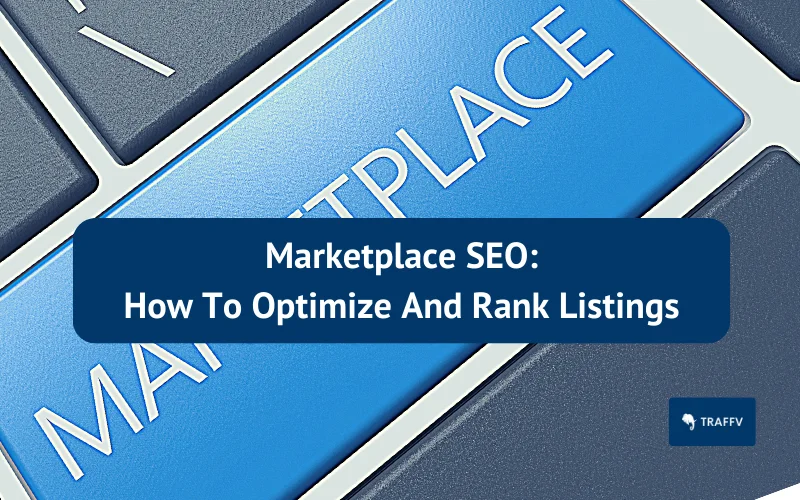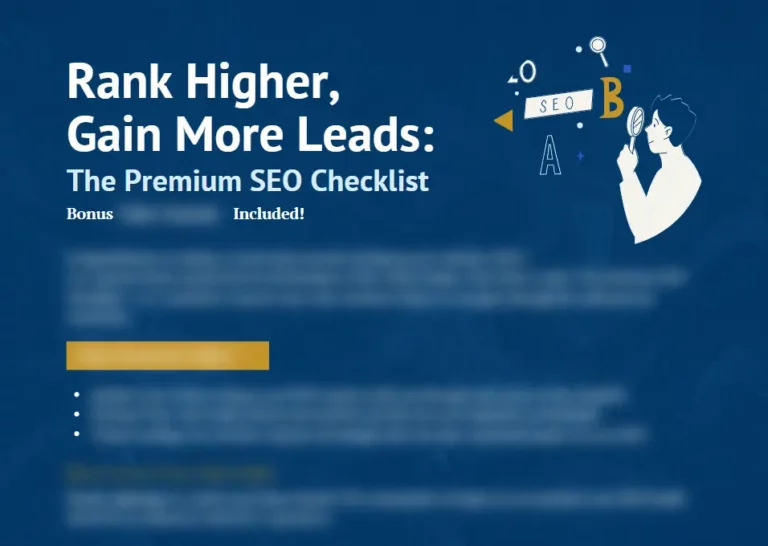Welcome to the dynamic world of Marketplace SEO, the unsung hero behind successful online marketplaces.
A world that’s constantly evolving, creating new challenges and opportunities for businesses seeking to make their mark in the digital sphere.
In this post, we’ll demystify Marketplace SEO, journeying from the intricacies of on-page factors to the technicalities of site architecture, and from the power of user-generated content to the subtle art of link building.
Buckle up, and let’s explore the fascinating world of Marketplace SEO!
TL:DR
- Marketplace SEO is the process of optimizing product listings to increase visibility, drive web traffic and enhance sales.
- It involves activities such as keyword research, leveraging user-generated content and utilizing tools like Google Search Console.
Step 1) Optimizing On-Page Factors
Imagine your marketplace website as a bustling city.
Your product listings are the buildings, each one unique and offering something different.
The roads connecting these buildings are your on-page factors – the elements on your website that can be optimized to guide visitors and search engines alike.
Much like city planners ensure roads are well-laid and signage is clear, successful marketplace SEO requires meticulous attention to on-page factors.
From keyword research to leveraging user-generated content, on-page optimization forms the bedrock of a robust marketplace SEO strategy.
Utilizing tools like Google Search Console can further enhance your efforts in search engine optimization, including traditional SEO practices.
Keyword Research
In the bustling city of our marketplace website, keyword research is akin to understanding the language of its inhabitants.
It’s about identifying the words and phrases your target audience uses when they’re looking for products like yours on search engines.
And it’s not just about finding the most popular keywords.
It’s about understanding the intent behind these search terms and considering the search volume for a comprehensive seo analysis.
Think of it as eavesdropping on your potential customers’ conversations – what are they talking about? What words are they using?
You can employ marketplace-specific keyword research tools, even observe the autofill or related search suggestions of your marketplace site’s internal search bar.
By understanding and leveraging these keywords, you can better cater to your audience and boost your visibility in search engine result pages.
Optimizing Product Listings
Optimizing product listings is like designing storefronts in our marketplace city.
It’s about making sure each product looks appealing, provides all the necessary information, and stands out from the crowd.
After all, the way you present your products can significantly impact their visibility in search results and, ultimately, your sales.
Creating a compelling product title is a fundamental step.
It should be concise yet descriptive, containing your brand name and target product keyword.
Similarly, a detailed product description is essential, highlighting important features that make the product unique.
And let’s not forget about the product images – high-quality images with added alt text can significantly enhance SEO.
Leveraging User-Generated Content
In the realm of our marketplace city, the citizens are not mere observers.
They’re active participants, contributing to the city’s growth and evolution.
This is where user-generated content comes into play.
From reviews to images, user-generated content adds a layer of authenticity to your listings and differentiates your site from competitors.
Consider user-generated content as the word-of-mouth in our marketplace city.
It’s the chatter in the coffee shops, the recommendations shared among friends.
It’s the reviews that reassure prospective buyers, the user images that showcase your products in real-world settings.
Leveraging this content can not only optimize your product listings, but also enhance your SEO performance.
Using Reviews to Boost Engagement
In our bustling marketplace city, reviews are the town crier, proclaiming the quality of your products to all who will listen.
Encouraging customers to leave reviews after purchasing can significantly enhance engagement and trust, signalling to search engines that your site is genuine.
Reviews provide a glimpse of the product experience from a user’s perspective, aiding potential customers in making informed decisions.
So, make it easy for customers to leave reviews, perhaps by providing incentives or linking the review page in your communications.
After all, a city that listens to its citizens is a city that thrives.
2) Fixing Technical Aspects
Beyond the bustling streets and towering product listings of our marketplace city lies the intricate network of pipes and wires – the technical aspects that keep the city running smoothly.
These elements, often unseen by visitors, are crucial to the city’s functionality and prosperity.
In the same vein, addressing the technical aspects of your marketplace site can have a significant impact on your search engine rankings.
Some key technical aspects to consider are:
- Site architecture
- Mobile-friendliness
- Security
- Schema markup
By optimizing these technical elements, you can improve your site’s visibility and attract more organic traffic.
Site Architecture and Navigation
Imagine the roads in our marketplace city.
Well-laid roads ensure smooth traffic flow, enabling citizens and visitors to reach their desired destinations without hassle.
Similarly, a well-planned site architecture and clear navigation system can enhance the user experience and aid search engine bots in comprehending the structure of your website.
Breadcrumbs, much like signposts in our city, play a crucial role in this aspect.
They provide users with a convenient navigation system and allow search engine bots to understand your website’s structure better, thereby enabling them to index its content more efficiently.
In essence, an organized site architecture and intuitive navigation system lay the groundwork for thriving ecommerce websites, creating a marketplace city.
Mobile-Friendliness and Page Speed
In our bustling marketplace city, imagine the streets teeming with people, all in a hurry to reach their destinations.
They expect the city to be navigable and efficient, with minimal hurdles. This is where mobile-friendliness and page speed come into play.
In an age where online shoppers are increasingly using mobile devices, it’s crucial to ensure your marketplace site is optimized for mobile.
Moreover, just as citizens in our city wouldn’t appreciate slow-moving traffic, online shoppers expect webpages to load quickly.
Slow-loading pages can lead to frustration, potentially causing visitors to abandon your site and damaging your search engine rankings.
Prioritizing mobile-friendliness and fast-loading pages can enhance your marketplace’s visibility in search engine ranking algorithms and cater to the needs of modern online shoppers.
Security and SSL Encryption
In our marketplace city, security is paramount.
Citizens and visitors alike need to feel safe, knowing that the city has measures in place to protect them.
Similarly, security is a vital aspect of any marketplace site.
Implementing SSL encryption, a security protocol that provides encrypted data transmission between a website and a user’s browser, is key to safeguarding user data and ensuring that your website is secure.
Moreover, a secure marketplace site isn’t just crucial for users. It also plays a significant role in search engine rankings.
Search engines like Google consider site security as a ranking factor, rewarding secure sites with better rankings.
So, by implementing SSL encryption, you’ll not only be providing a safer environment for your users, but also boosting your site’s visibility in search engine result pages.
Schema Markup
Imagine the city directories in our marketplace city.
They give visitors a detailed overview of what the city offers, helping them navigate more efficiently.
Schema markup plays a similar role in your marketplace site.
It’s a type of code that helps search engines better understand the information present on your site, creating an enhanced description that’s visible within search engine results.
Utilizing schema markup can assist search engines in comprehending your site’s content, potentially resulting in increased visibility in search results.
It can also help display additional information in search results, such as product reviews and details, providing potential customers with more information at a glance.
So think of schema markup as your site’s directory, guiding both search engines and users to the right place.
3) Building Off-Page SEO
While on-page and technical SEO focus on enhancing the cityscape of our marketplace city, building off-page SEO is about extending its influence beyond the city limits.
It’s about creating connections with neighboring cities and increasing your city’s reputation.
Through content marketing, link building, and localized SEO strategies, you can further boost your marketplace site’s search rankings, extending its reach and enhancing its visibility.
Content Marketing
In our marketplace city, content marketing is like a town crier, spreading the news about the city’s offerings far and wide.
By creating and distributing valuable, relevant content, you can attract and retain a clearly defined audience, establishing your marketplace’s expertise and promoting brand awareness.
Creating high-quality content isn’t just about writing well.
It’s about:
- Researching topics relevant to your audience
- Incorporating visuals to enhance engagement
- Optimizing for search engine visibility
- Sharing this content on social channels and with influencers
These strategies can further enhance your site’s visibility, garnering attention and attracting potential customers to your marketplace city.
Link Building
In our city analogy, link building is akin to establishing trade routes with other cities.
These links, or routes, from other websites to your own can significantly enhance your marketplace’s visibility in search engine results.
Acquiring links isn’t just about quantity; quality matters too.
Building relationships with authoritative sites in your niche and leveraging unique data can help you acquire hard-to-get links.
Like establishing profitable trade routes, successful link building requires strategic planning and execution, ultimately enhancing your marketplace’s reputation and visibility.
Localized SEO Strategy
Just as our marketplace city caters to its local citizens, a localized SEO strategy focuses on optimizing your marketplace site to attract local customers.
This strategy is all about creating location-specific pages and targeting “near me” queries, making your site more relevant and visible to local searchers.
Local SEO isn’t just for physical businesses with local presences; even online marketplaces can benefit from it.
By developing a localized SEO strategy, you ensure that your marketplace city is not just visible on a global scale, but also stands out in its local community, attracting and catering to local customers effectively.
What is Marketplace SEO?
After traversing through the bustling streets of our marketplace city, let’s take a step back and look at the city from a bird’s eye view.
SEO for marketplaces, at its core, is the process of optimizing product listings on ecommerce platforms to maximize visibility, drive web traffic, and enhance sales.
Just as a city planner meticulously plans and oversees the functioning of a city, successful marketplace SEO requires a strategic approach, from keyword research to user-generated content, and from on-page optimization to tackling technical aspects.
The goal?
To signal to search engines like Google that your marketplace is the most suitable for a particular search query, increase organic traffic, and ultimately, boost sales.
Difference Between Market Place SEO and Ecommerce SEO
At first glance, our online marketplace may seem similar to an ecommerce city.
However, upon closer inspection and comparing marketplace SEO with traditional ecommerce SEO, we find that these are two distinct entities, each with its unique opportunities and challenges.
Marketplace SEO is distinct from traditional ecommerce SEO as it concentrates on optimizing listings with commercial intent and addressing the specific difficulties associated with third-party vendors on marketplace sites.
While ecommerce SEO focuses on optimizing an ecommerce site, marketplace SEO involves optimizing product listings on a marketplace site, where multiple third-party vendors offer their products.
For instance, a search for “little black dress online” will typically display marketplace results, whereas a search for “the best outfits for a year end dinner” will yield articles and blogs in the initial positions.
Navigating the Intricacies of Marketplace SEO
In our journey through the bustling city of Marketplace SEO, we’ve explored the intricacies of on-page factors, delved into the technical aspects of site architecture, and seen the power of user-generated content.
So, whether you’re launching a new marketplace city or looking to enhance an existing one, working with an SEO agency can help you navigate the world of Marketplace SEO more effectively, leading to a thriving marketplace city.
So, here’s to successful SEO strategies and thriving marketplace cities!
Learn how to do SEO for popular platforms:
Frequently Asked Questions
What is marketplace SEO?
Marketplace SEO focuses on optimizing online marketplaces to increase visibility and attract more customers by targeting relevant keywords, improving content, and optimizing technical aspects.
How do I optimize my marketplace listing?
To optimize your marketplace listing, make sure your product title is optimized, your product description is detailed and accurate, and include product FAQs.
Additionally, use customer reviews to gauge what aspects of your product could be improved upon and consider featuring it or running advertisements.
What is SEO in product listing?
Search Engine Optimization (SEO) is an essential element for improving visibility of product listings on search engines.
SEO techniques involve optimizing website content and product listings for keywords to increase visibility in search engine results and attract more traffic.
Amazon SEO involves optimizing product listings to rank higher in product searches, thereby boosting sales and helping shoppers find brands.
What is the difference between Marketplace SEO and Ecommerce SEO?
Marketplace SEO differs from ecommerce SEO as it focuses on optimizing third-party vendor listings with commercial intent and specific difficulties.




